TOYOTA GT86 2013 Owners Manual (in English)
Manufacturer: TOYOTA, Model Year: 2013, Model line: GT86, Model: TOYOTA GT86 2013Pages: 448, PDF Size: 13.47 MB
Page 121 of 448
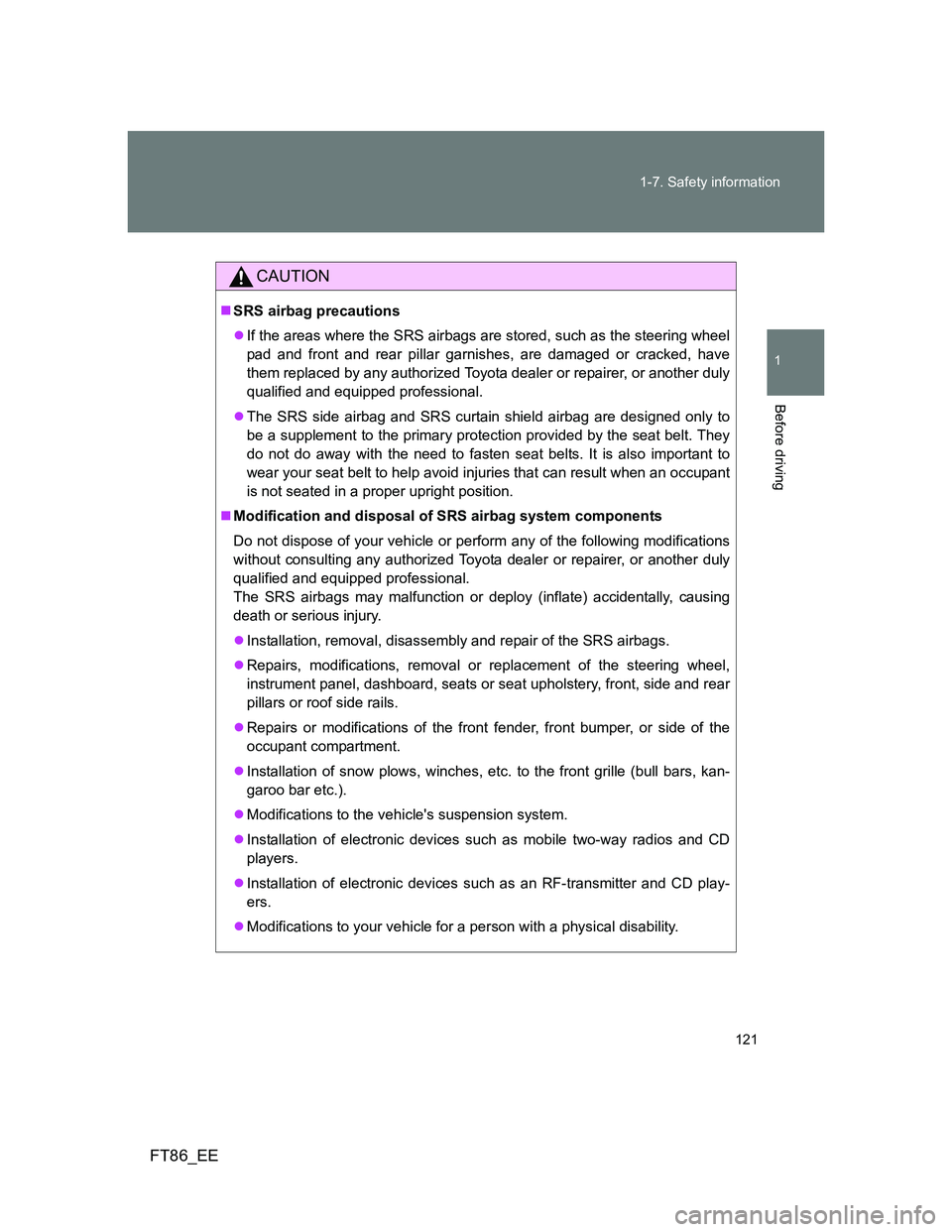
121 1-7. Safety information
1
Before driving
FT86_EE
CAUTION
SRS airbag precautions
If the areas where the SRS airbags are stored, such as the steering wheel
pad and front and rear pillar garnishes, are damaged or cracked, have
them replaced by any authorized Toyota dealer or repairer, or another duly
qualified and equipped professional.
The SRS side airbag and SRS curtain shield airbag are designed only to
be a supplement to the primary protection provided by the seat belt. They
do not do away with the need to fasten seat belts. It is also important to
wear your seat belt to help avoid injuries that can result when an occupant
is not seated in a proper upright position.
Modification and disposal of SRS airbag system components
Do not dispose of your vehicle or perform any of the following modifications
without consulting any authorized Toyota dealer or repairer, or another duly
qualified and equipped professional.
The SRS airbags may malfunction or deploy (inflate) accidentally, causing
death or serious injury.
Installation, removal, disassembly and repair of the SRS airbags.
Repairs, modifications, removal or replacement of the steering wheel,
instrument panel, dashboard, seats or seat upholstery, front, side and rear
pillars or roof side rails.
Repairs or modifications of the front fender, front bumper, or side of the
occupant compartment.
Installation of snow plows, winches, etc. to the front grille (bull bars, kan-
garoo bar etc.).
Modifications to the vehicle's suspension system.
Installation of electronic devices such as mobile two-way radios and CD
players.
Installation of electronic devices such as an RF-transmitter and CD play-
ers.
Modifications to your vehicle for a person with a physical disability.
Page 122 of 448
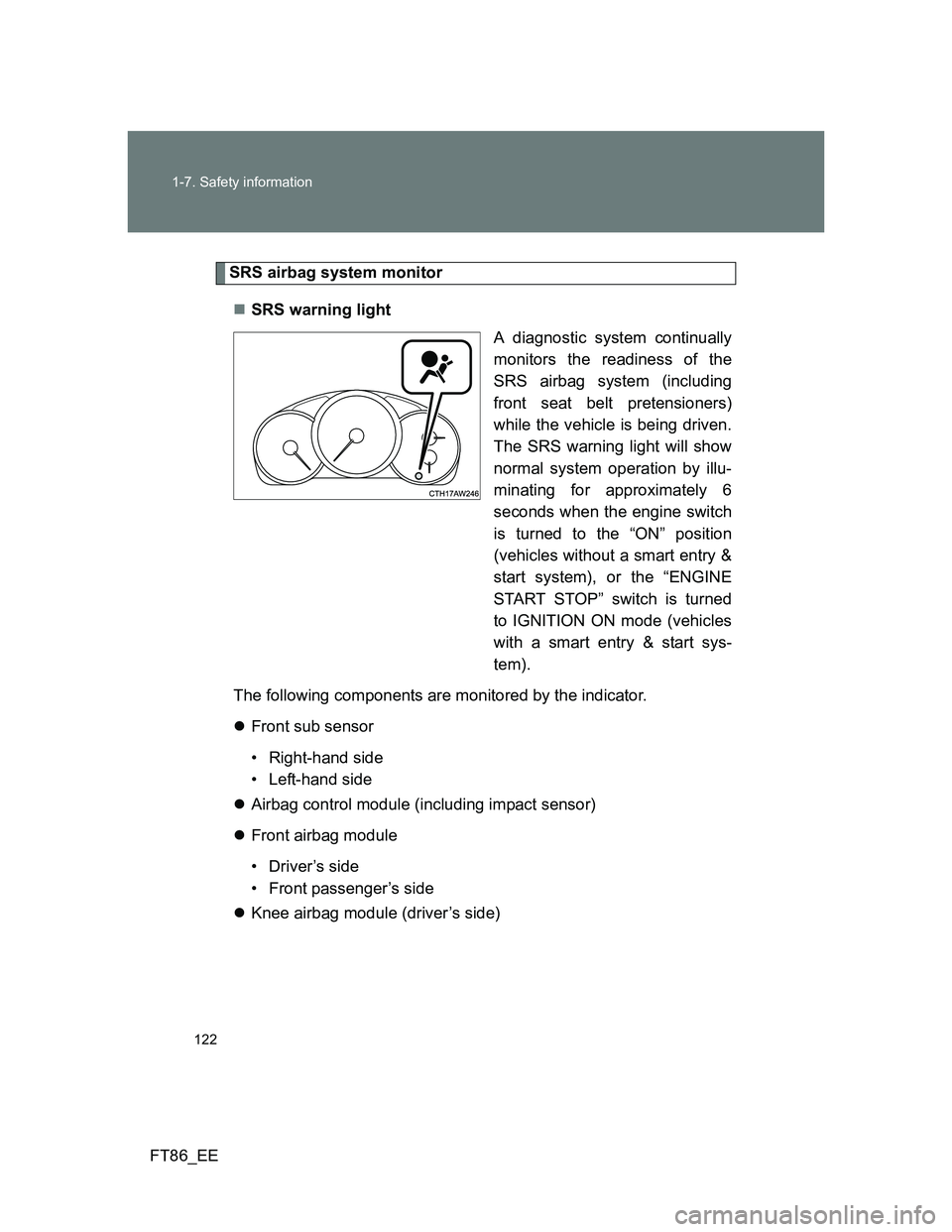
122 1-7. Safety information
FT86_EE
SRS airbag system monitor
SRS warning light
A diagnostic system continually
monitors the readiness of the
SRS airbag system (including
front seat belt pretensioners)
while the vehicle is being driven.
The SRS warning light will show
normal system operation by illu-
minating for approximately 6
seconds when the engine switch
is turned to the “ON” position
(vehicles without a smart entry &
start system), or the “ENGINE
START STOP” switch is turned
to IGNITION ON mode (vehicles
with a smart entry & start sys-
tem).
The following components are monitored by the indicator.
Front sub sensor
• Right-hand side
• Left-hand side
Airbag control module (including impact sensor)
Front airbag module
• Driver’s side
• Front passenger’s side
Knee airbag module (driver’s side)
Page 123 of 448
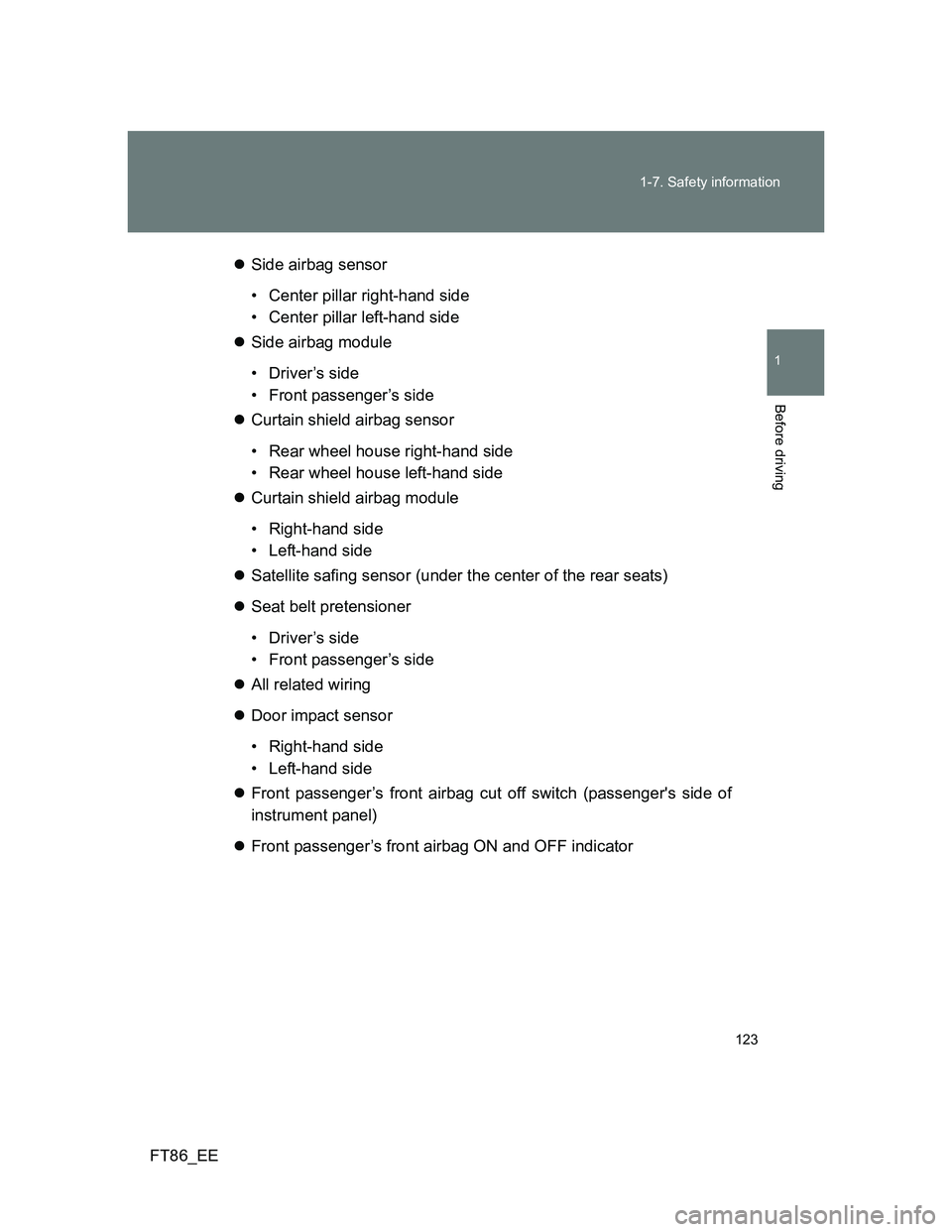
123 1-7. Safety information
1
Before driving
FT86_EESide airbag sensor
• Center pillar right-hand side
• Center pillar left-hand side
Side airbag module
• Driver’s side
• Front passenger’s side
Curtain shield airbag sensor
• Rear wheel house right-hand side
• Rear wheel house left-hand side
Curtain shield airbag module
• Right-hand side
• Left-hand side
Satellite safing sensor (under the center of the rear seats)
Seat belt pretensioner
• Driver’s side
• Front passenger’s side
All related wiring
Door impact sensor
• Right-hand side
• Left-hand side
Front passenger’s front airbag cut off switch (passenger's side of
instrument panel)
Front passenger’s front airbag ON and OFF indicator
Page 124 of 448
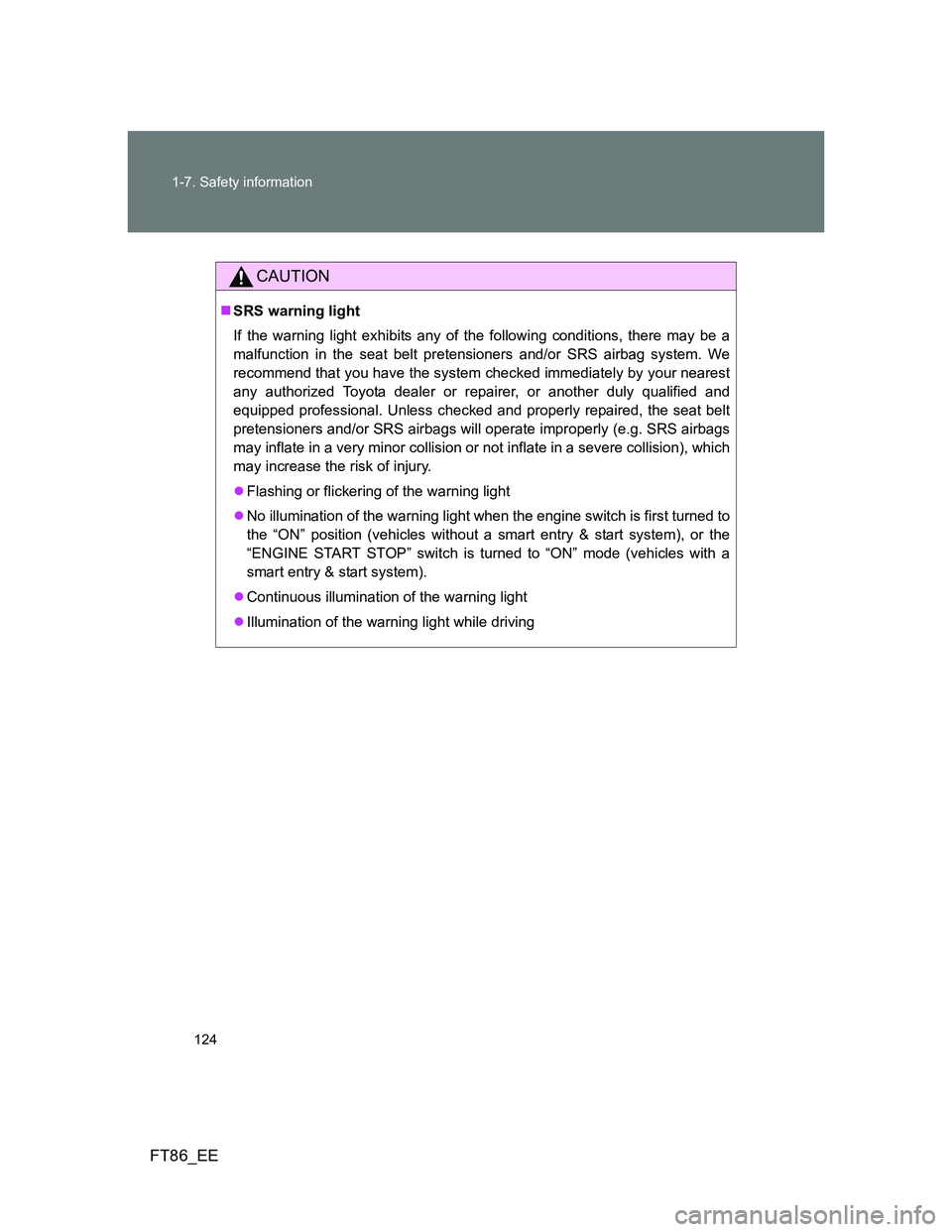
124 1-7. Safety information
FT86_EE
CAUTION
SRS warning light
If the warning light exhibits any of the following conditions, there may be a
malfunction in the seat belt pretensioners and/or SRS airbag system. We
recommend that you have the system checked immediately by your nearest
any authorized Toyota dealer or repairer, or another duly qualified and
equipped professional. Unless checked and properly repaired, the seat belt
pretensioners and/or SRS airbags will operate improperly (e.g. SRS airbags
may inflate in a very minor collision or not inflate in a severe collision), which
may increase the risk of injury.
Flashing or flickering of the warning light
No illumination of the warning light when the engine switch is first turned to
the “ON” position (vehicles without a smart entry & start system), or the
“ENGINE START STOP” switch is turned to “ON” mode (vehicles with a
smart entry & start system).
Continuous illumination of the warning light
Illumination of the warning light while driving
Page 125 of 448
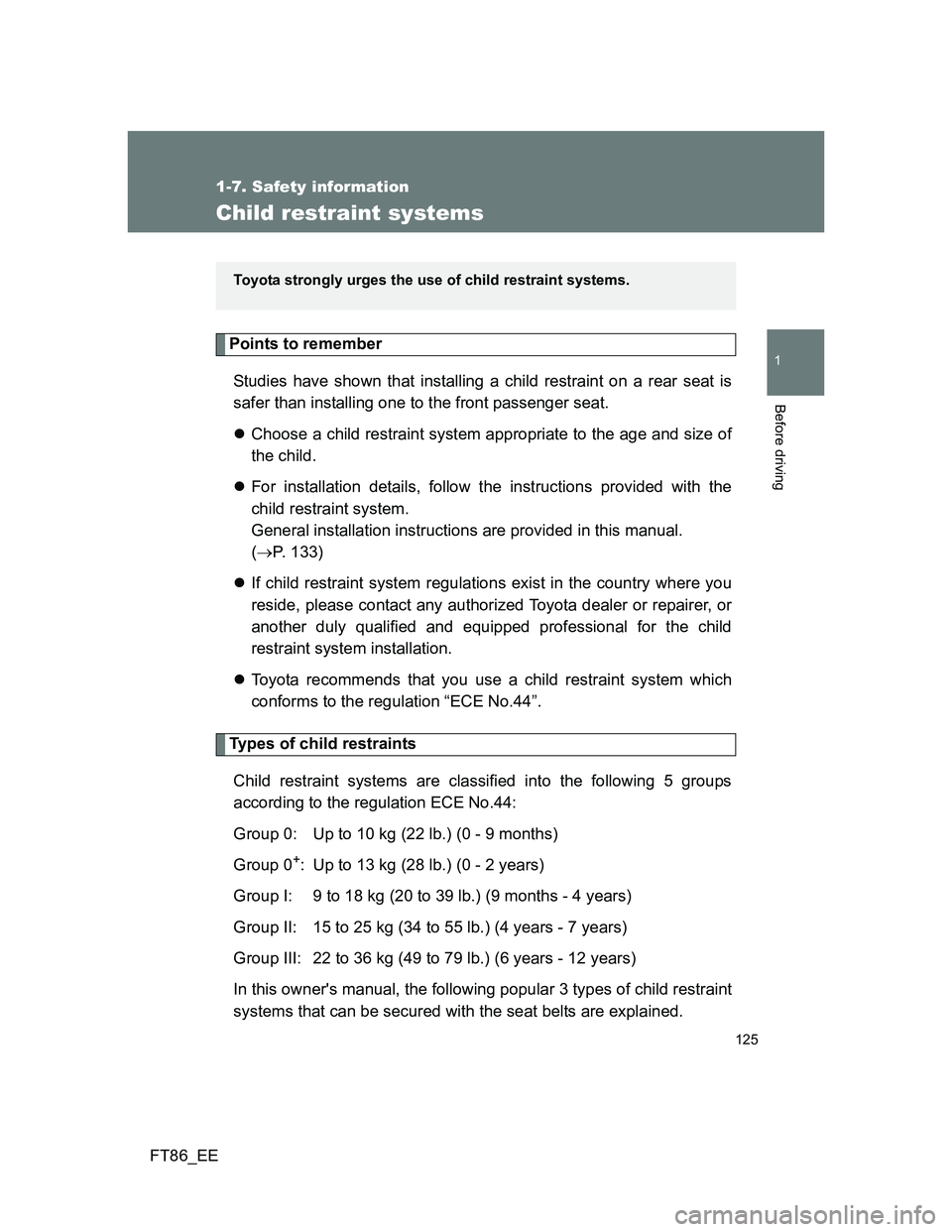
125
1
1-7. Safety information
Before driving
FT86_EE
Child restraint systems
Points to remember
Studies have shown that installing a child restraint on a rear seat is
safer than installing one to the front passenger seat.
Choose a child restraint system appropriate to the age and size of
the child.
For installation details, follow the instructions provided with the
child restraint system.
General installation instructions are provided in this manual.
(P. 133)
If child restraint system regulations exist in the country where you
reside, please contact any authorized Toyota dealer or repairer, or
another duly qualified and equipped professional for the child
restraint system installation.
Toyota recommends that you use a child restraint system which
conforms to the regulation “ECE No.44”.
Types of child restraints
Child restraint systems are classified into the following 5 groups
according to the regulation ECE No.44:
Group 0: Up to 10 kg (22 lb.) (0 - 9 months)
Group 0
+: Up to 13 kg (28 lb.) (0 - 2 years)
Group I: 9 to 18 kg (20 to 39 lb.) (9 months - 4 years)
Group II: 15 to 25 kg (34 to 55 lb.) (4 years - 7 years)
Group III: 22 to 36 kg (49 to 79 lb.) (6 years - 12 years)
In this owner's manual, the following popular 3 types of child restraint
systems that can be secured with the seat belts are explained.
Toyota strongly urges the use of child restraint systems.
Page 126 of 448
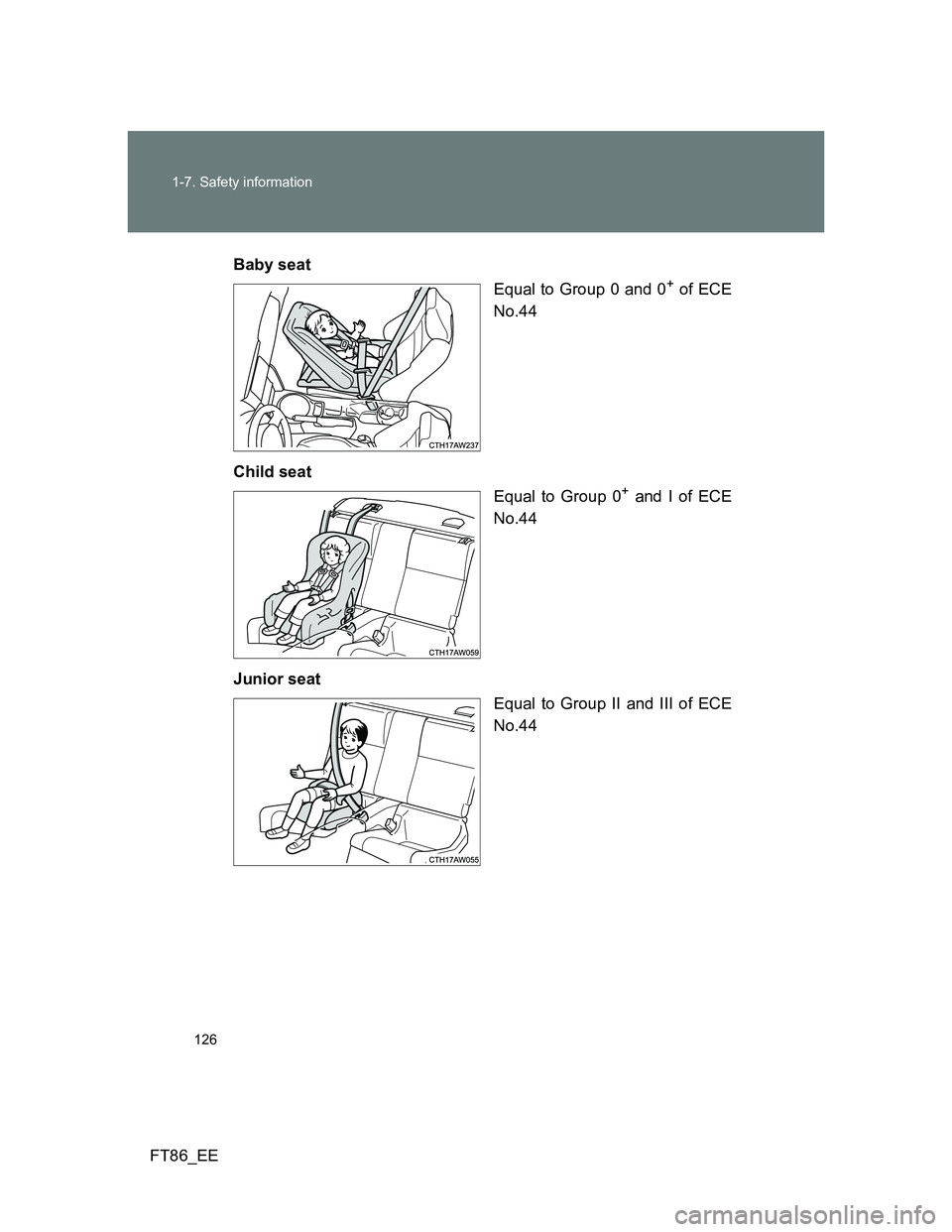
126 1-7. Safety information
FT86_EEBaby seat
Equal to Group 0 and 0
+ of ECE
No.44
Child seat
Equal to Group 0
+ and I of ECE
No.44
Junior seat
Equal to Group II and III of ECE
No.44
Page 127 of 448
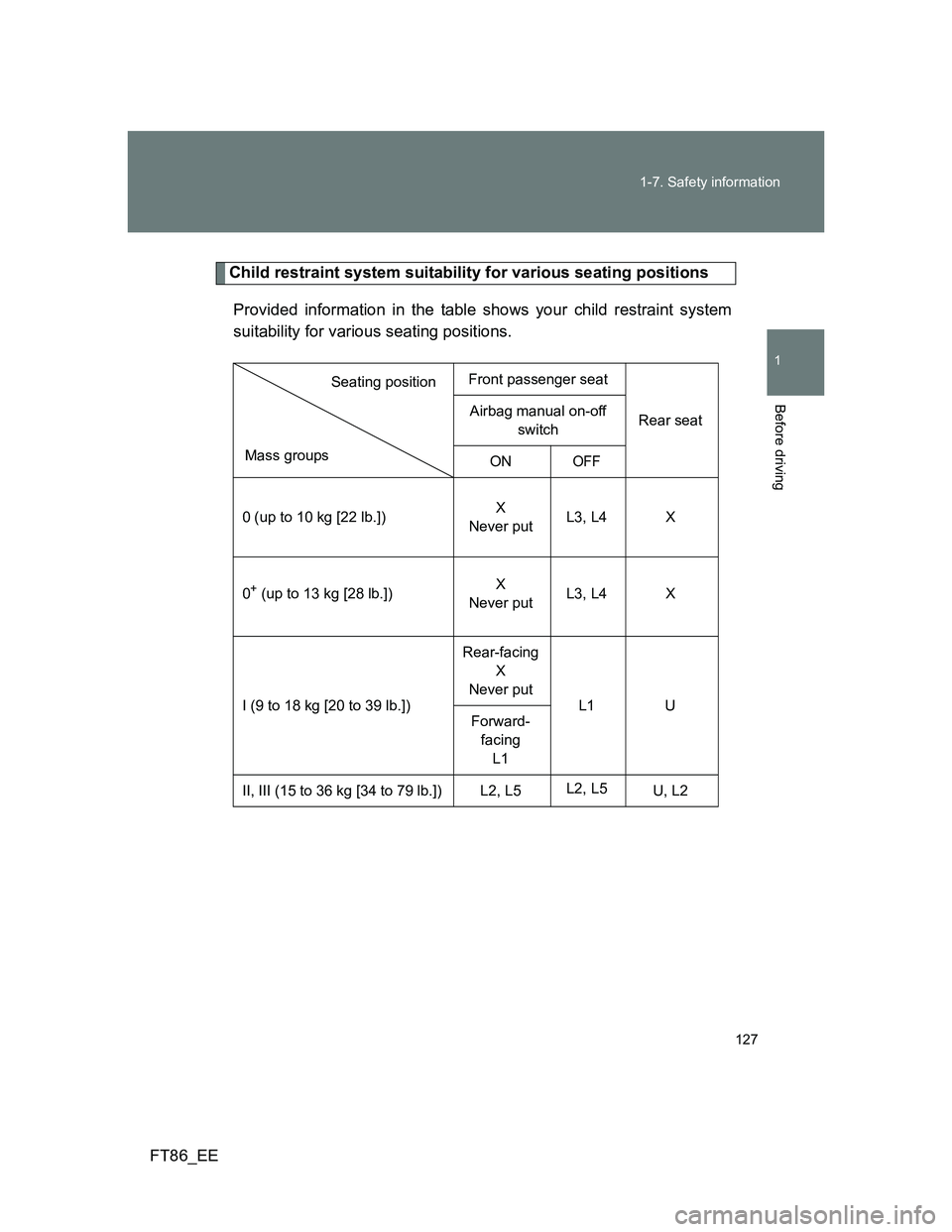
127 1-7. Safety information
1
Before driving
FT86_EE
Child restraint system suitability for various seating positions
Provided information in the table shows your child restraint system
suitability for various seating positions.
Front passenger seat
Rear seat Airbag manual on-off
switch
ON
OFF
0 (up to 10 kg [22 lb.])X
Never putL3, L4 X
0
+ (up to 13 kg [28 lb.])X
Never putL3, L4 X
I (9 to 18 kg [20 to 39 lb.])Rear-facing
X
Never put
L1 U
Forward-
facing
L1
II, III (15 to 36 kg [34 to 79 lb.]) L2, L5L2, L5
U, L2
Mass groupsSeating position
Page 128 of 448
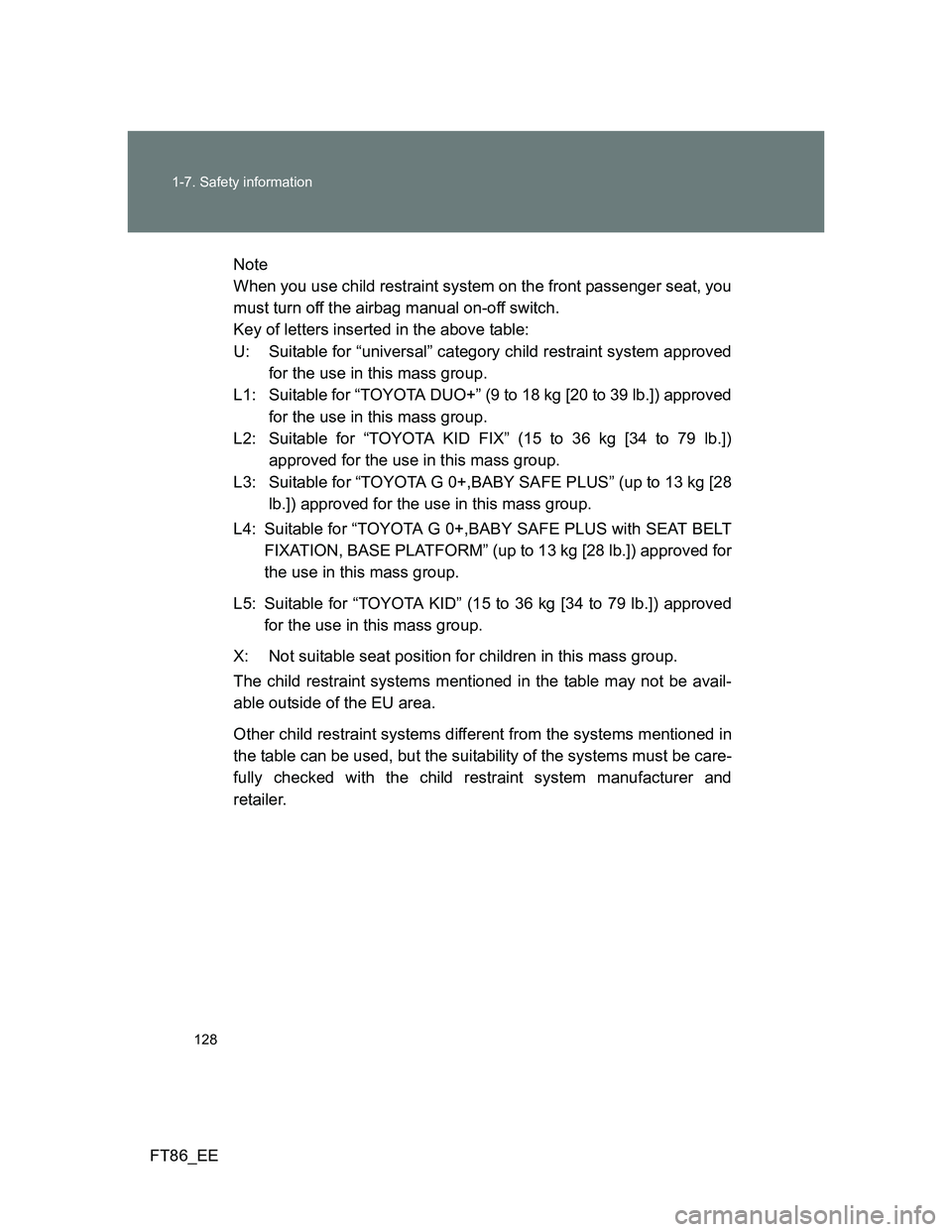
128 1-7. Safety information
FT86_EENote
When you use child restraint system on the front passenger seat, you
must turn off the airbag manual on-off switch.
Key of letters inserted in the above table:
U: Suitable for “universal” category child restraint system approved
for the use in this mass group.
L1: Suitable for “TOYOTA DUO+” (9 to 18 kg [20 to 39 lb.]) approved
for the use in this mass group.
L2: Suitable for “TOYOTA KID FIX” (15 to 36 kg [34 to 79 lb.])
approved for the use in this mass group.
L3: Suitable for “TOYOTA G 0+,BABY SAFE PLUS” (up to 13 kg [28
lb.]) approved for the use in this mass group.
L4: Suitable for “TOYOTA G 0+,BABY SAFE PLUS with SEAT BELT
FIXATION, BASE PLATFORM” (up to 13 kg [28 lb.]) approved for
the use in this mass group.
L5: Suitable for “TOYOTA KID” (15 to 36 kg [34 to 79 lb.]) approved
for the use in this mass group.
X: Not suitable seat position for children in this mass group.
The child restraint systems mentioned in the table may not be avail-
able outside of the EU area.
Other child restraint systems different from the systems mentioned in
the table can be used, but the suitability of the systems must be care-
fully checked with the child restraint system manufacturer and
retailer.
Page 129 of 448
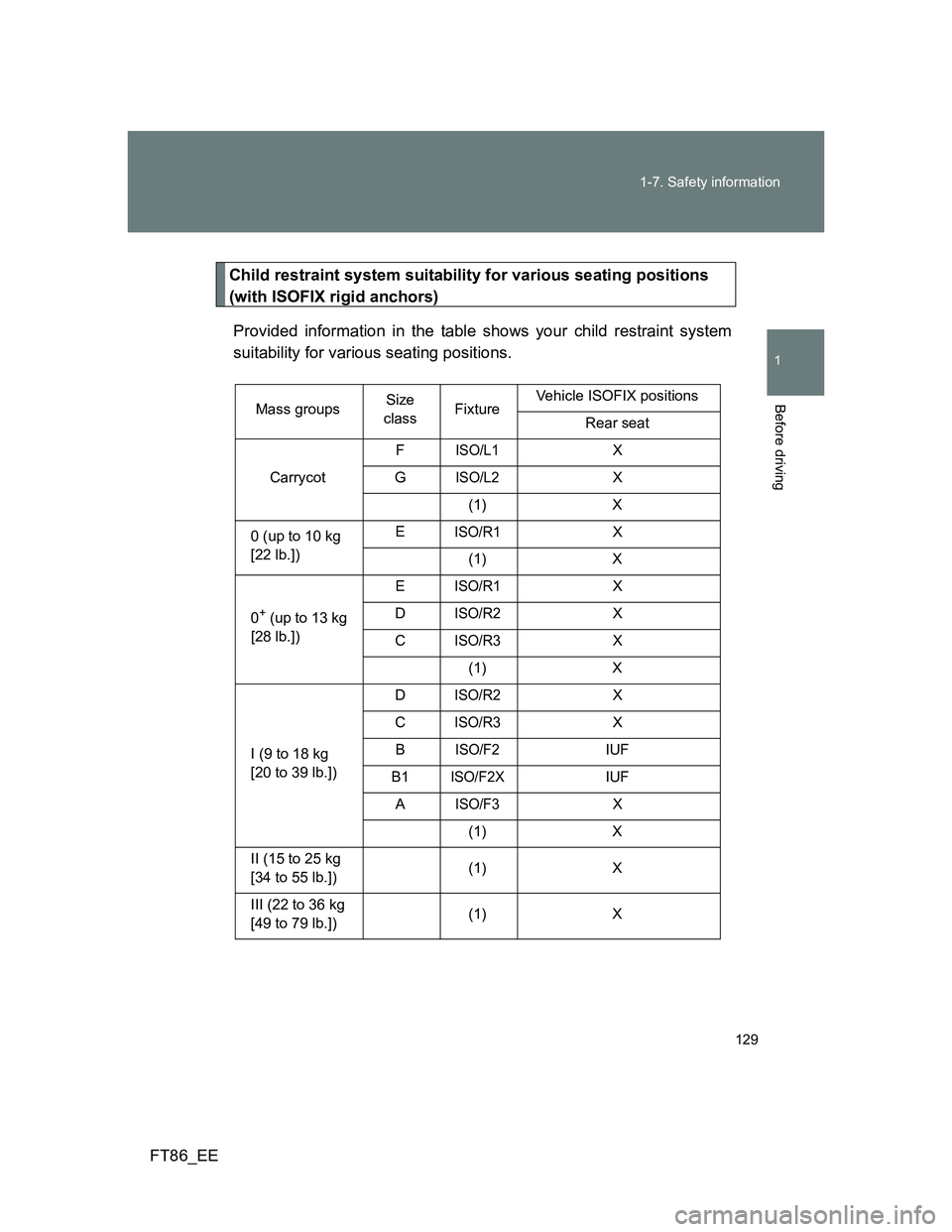
129 1-7. Safety information
1
Before driving
FT86_EE
Child restraint system suitability for various seating positions
(with ISOFIX rigid anchors)
Provided information in the table shows your child restraint system
suitability for various seating positions.
Mass groupsSize
classFixtureVehicle ISOFIX positions
Rear seat
CarrycotF
ISO/L1X
G
ISO/L2X
(1) X
0 (up to 10 kg
[22 lb.])E
ISO/R1X
(1) X
0
+ (up to 13 kg
[28 lb.])E
ISO/R1X
D
ISO/R2X
C
ISO/R3X
(1) X
I (9 to 18 kg
[20 to 39 lb.])D
ISO/R2X
C
ISO/R3X
B
ISO/F2IUF
B1
ISO/F2XIUF
A
ISO/F3X
(1) X
II (15 to 25 kg
[34 to 55 lb.])(1) X
III (22 to 36 kg
[49 to 79 lb.])(1) X
Page 130 of 448
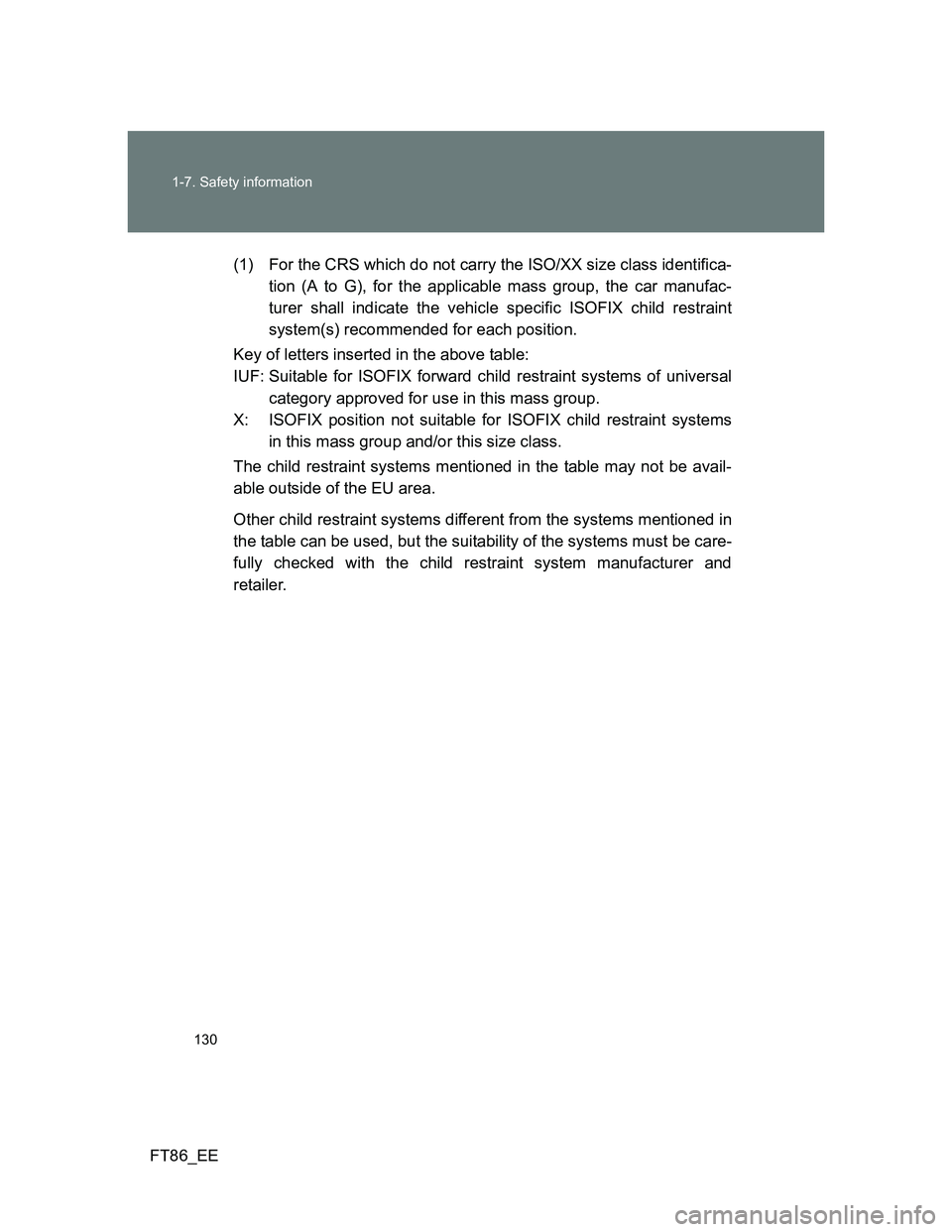
130 1-7. Safety information
FT86_EE(1) For the CRS which do not carry the ISO/XX size class identifica-
tion (A to G), for the applicable mass group, the car manufac-
turer shall indicate the vehicle specific ISOFIX child restraint
system(s) recommended for each position.
Key of letters inserted in the above table:
IUF: Suitable for ISOFIX forward child restraint systems of universal
category approved for use in this mass group.
X: ISOFIX position not suitable for ISOFIX child restraint systems
in this mass group and/or this size class.
The child restraint systems mentioned in the table may not be avail-
able outside of the EU area.
Other child restraint systems different from the systems mentioned in
the table can be used, but the suitability of the systems must be care-
fully checked with the child restraint system manufacturer and
retailer.